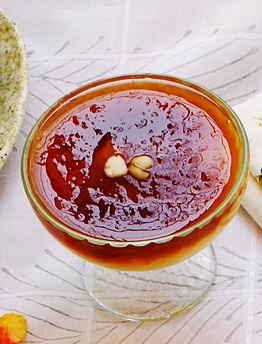Khubani-ka-Meetha
Khubani-ka-Meetha[edit | edit source]
Khubani-ka-Meetha is a traditional Hyderabadi dessert made from dried apricots. It is a popular sweet dish in the region of Hyderabad, India, and is often served at weddings and festive occasions. The name "Khubani-ka-Meetha" translates to "sweet of apricots" in Urdu.
Ingredients[edit | edit source]
The primary ingredient in Khubani-ka-Meetha is dried apricots, known as "khubani" in Urdu. Other essential ingredients include sugar, water, and sometimes almonds or pistachios for garnishing. Some variations may include a hint of rose water or saffron for added flavor.
Preparation[edit | edit source]
The preparation of Khubani-ka-Meetha involves soaking the dried apricots in water overnight to rehydrate them. Once softened, the apricots are cooked with sugar until they form a thick, syrupy consistency. The seeds of the apricots are often cracked open to extract the kernels, which are then added to the dish for a nutty flavor.
Cooking Process[edit | edit source]
1. Soaking: The dried apricots are soaked in water overnight to soften them. 2. Cooking: The soaked apricots are cooked with sugar and water until they break down into a thick, sweet sauce. 3. Garnishing: The dish is garnished with slivers of almonds or pistachios and sometimes flavored with rose water or saffron.
Serving[edit | edit source]
Khubani-ka-Meetha is typically served warm or at room temperature. It can be enjoyed on its own or paired with ice cream or custard to enhance its richness. The dessert is often presented in small bowls or cups, making it easy to serve at large gatherings.
Cultural Significance[edit | edit source]
Khubani-ka-Meetha holds a special place in Hyderabadi culture and is a staple at weddings and special occasions. It reflects the rich culinary heritage of the region, which is known for its unique blend of Mughlai and Deccan flavors. The dessert's sweet and tangy taste, combined with its aromatic garnishes, makes it a favorite among locals and visitors alike.
Related Pages[edit | edit source]
Search WikiMD
Ad.Tired of being Overweight? Try W8MD's NYC physician weight loss.
Semaglutide (Ozempic / Wegovy and Tirzepatide (Mounjaro / Zepbound) available. Call 718 946 5500.
Advertise on WikiMD
|
WikiMD's Wellness Encyclopedia |
| Let Food Be Thy Medicine Medicine Thy Food - Hippocrates |
Translate this page: - East Asian
中文,
日本,
한국어,
South Asian
हिन्दी,
தமிழ்,
తెలుగు,
Urdu,
ಕನ್ನಡ,
Southeast Asian
Indonesian,
Vietnamese,
Thai,
မြန်မာဘာသာ,
বাংলা
European
español,
Deutsch,
français,
Greek,
português do Brasil,
polski,
română,
русский,
Nederlands,
norsk,
svenska,
suomi,
Italian
Middle Eastern & African
عربى,
Turkish,
Persian,
Hebrew,
Afrikaans,
isiZulu,
Kiswahili,
Other
Bulgarian,
Hungarian,
Czech,
Swedish,
മലയാളം,
मराठी,
ਪੰਜਾਬੀ,
ગુજરાતી,
Portuguese,
Ukrainian
Medical Disclaimer: WikiMD is not a substitute for professional medical advice. The information on WikiMD is provided as an information resource only, may be incorrect, outdated or misleading, and is not to be used or relied on for any diagnostic or treatment purposes. Please consult your health care provider before making any healthcare decisions or for guidance about a specific medical condition. WikiMD expressly disclaims responsibility, and shall have no liability, for any damages, loss, injury, or liability whatsoever suffered as a result of your reliance on the information contained in this site. By visiting this site you agree to the foregoing terms and conditions, which may from time to time be changed or supplemented by WikiMD. If you do not agree to the foregoing terms and conditions, you should not enter or use this site. See full disclaimer.
Credits:Most images are courtesy of Wikimedia commons, and templates, categories Wikipedia, licensed under CC BY SA or similar.
Contributors: Prab R. Tumpati, MD


